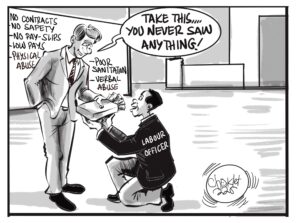Transparency International Zambia has questioned the monopoly and single sourcing of AVIC International for major government contracts such as the construction of Toll Plazas across the country.
And TIZ is demanding for an explanation as to why the Kafulafuta Toll Plaza which is being constructed on a single carriageway is costing US$4.2 million, just as much as the Michael Sata Toll Plaza which was constructed on a dual carriageway.
On Monday, News Diggers! published an expose´ revealing that the Road Development Agency single sourced AVIC International to construct three tollgates at an initial cost of about US$12.9 million, among them, the controversial Michael Sata Toll Plaza and the Kafulafuta Toll Plaza which together cost about US$8.5 million.
The investigation further revealed that despite spending around US$1.2 million just on the tolling building facility, installation of “state of the art” tolling systems, power supply, signal lighting for traffic and tolling as well as surveillance systems, the toll collection mechanism at Michael Sata Toll Plaza started breaking down shortly after it was commissioned; forcing toll officers to issue handwritten receipts to motorists.
And the Road Development Agency confirmed that the Chinese company was single sourced to construct the tolling facilities, while the National Road Fund Agency also confirmed that the Michael Sata Toll Plaza broke down twice, in a space of three months, barely five months after President Edgar Lungu officially commissioned it.
Commenting on the development, TIZ president Rueben Lifuka recalled that former Minister of Infrastructure Development Ronald Chitotela had justified the cost of the Michael Sata Toll Plaza on grounds that it was constructed on a dual carriageway.
“Public works such as the Toll plazas should be procured in a manner that helps the country achieve value for money. The investigative piece done by News Diggers highlights the concerns that we initially expressed about the seemingly high project cost which was not comparable to similar projects in the region. Many stakeholders queried what was so special about the Michael Chilufya Sata Toll plaza to be this expensive. At that time, Government through the Minister of Infrastructure Development and Housing- Hon Ronald Chitotela, vehemently defended the cost of the whole project. He went further to argue that this toll plaza covered four lane carriageway. The critical piece of information which the Minister did not avail to the general public, was that AVIC International was single sourced,” he said.
“We have a number of questions on why AVIC was singled sourced.To be clear we understand that Government was anxious to start getting revenues from the tolling projects but this is not sufficient justification for Government to pay for a very expensive project unless there are other motives. What is not clear is why was AVIC given three projects under this single sourced arrangement -Michael Chilufya Sata, Choma and Kafulafuta? It is not like AVIC was pumping in its own money in this project but Government was paying. What was the assessment of the value for money through this procurement? What we find uncomfortable is that RDA through its procurement committee, did recognise that the high rates proposed by AVIC were not comparable with previous works but why then did they not negotiate this with AVIC to get a more favourable cost for the three projects? RDA seems to have merely accepted the argument put forward by AVIC that the sites were far – but could this be the only reason for this inflated cost of the projects?”
He wondered why AVIC was paid US$95,000 as design fee when the Minister had said his ministry already engaged a different designer prior to the contract being awarded.
“In the Ministerial Statement that Hon Chitotela made in Parliament on 13 December 2018, he made some assertions which are now brought into question from this investigation. For instance, the Minister alluded to the fact that RDA engaged an independent consultant to prepare detailed design for the Michael Chilufya Toll Plaza, however, both from the Ministerial statement and from this investigation piece, it is evident that AVIC International did include nearly USD95,000 as design fees. The question is why did Government pay AVIC for design when it had already commissioned an independent consultant to do detailed designs which produced an estimate of USD6.6 million for this project?” Lifuka wondered.
“The marginal difference between the cost of the Michael Sata Toll Plaza and the Kafulafuta which is on a single carriageway, is a serious cause for concern. How does Government explain this, bearing in mind that initially, the argument was that the Sata Toll Plaza was the largest with state of the art facilities and therefore this cost was justified. What is now so special for the Kafulafuta toll plaza to be nearly as expensive as the largest toll plaza in the country? Government through Hon Chitotela did indicate that the Katuba and Shimabala toll plazas cost were USD2.8 million and USD2.2 million respectively, why then is the Kafulafuta Toll Plaza nearly 100 percent in cost?”
Lifuka demanded that the Auditor general takes interest in the Toll Plaza scandal so that the money trail can be followed, and demanded that government explains why AVIC has a monopoly of government contracts.
“The Auditor General should undertake a special financial audit to ascertain the utilisation of funds under this contract. This financial audit should be complemented with a technical and procurement audit to really ascertain whether as a country we received value for money on this project. Government should immediately review the potential abuse of single sourcing by different procurement entities. We have previously stated that we do understand there will be instances where single sourcing is justified but we wish to point out that this type of procurement is also prone to abuse and can easily serve as a conduit for corruption,” said Lifuka.
“Government should explain to the public why it has allowed a few private companies like AVIC to monopolise public projects. How possible is it that one company has such a big portfolio of public projects with potentially more in the pipeline? Competition through open and transparent procurement systems should be the default position of government. The continued weaknesses in the public procurement system is a source of growing concern and we call for political will to support detailed reforms in public procurement. It is time that Zambia adopted and implemented Open Contracting principles and standards.”
























